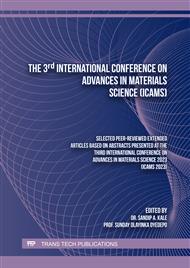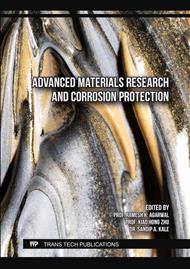[1]
U. Anthony, M. Ikenna, O. B. Ufuma, and D. T. Ezemuo, "Corrosion Rates and its Impact on Mild Steel in Some Selected Environments," J. Sci. Eng. Res., vol. 3, no. 1, p.34–43, 2016, [Online]. Available: http://jsaer.com/download/vol-3-iss-1-2016/JSAER2016-03-01-34-43.pdf
Google Scholar
[2]
A. V Amezhnov, I. G. Rodionova, D. V Kuznetsov, A. A. Komissarov, and E. P. Sidorova, "Effect of Heat Treatment on Corrosion Activity of Nonmetallic Inclusions and Steel Corrosion Resistance in Aqueous Media," vol. 62, no. 12, p.33–38, 2019.
DOI: 10.1007/s11015-019-00779-x
Google Scholar
[3]
H. E. Fathabadi, M. Ghorbani, and H. Mokarami Ghartavol, "Corrosion inhibition of mild steel with tolyltriazole," Mater. Res., vol. 24, no. 4, 2021.
DOI: 10.1590/1980-5373-MR-2020-0395
Google Scholar
[4]
O. S. I. Fayomi and I. G. Akande, "Corrosion Mitigation of Aluminium in 3.65% NaCl Medium Using Hexamine," J. Bio- Tribo-Corrosion, vol. 5, no. 1, p.0, 2019.
DOI: 10.1007/s40735-018-0214-4
Google Scholar
[5]
M. Pita and L. Lebea, "Investigating the Effect of Cooling Media on Hardness , Toughness , Coefficient of Friction , and Wear Rate of Mild Steel Heat Treated at Different Temperatures," Mater. Des. Process. Commun., vol. 2022, 2022.
DOI: 10.1155/2022/3564875
Google Scholar
[6]
L. Lebea and M. Pita, "The Effect of Cooling Media on the Corrosion Behavior of Mild Steel after Heat Treatment," Int. J. Emerg. Technol. Adv. Eng., vol. 12, no. 09, p.158–164, 2022.
DOI: 10.46338/ijetae0922_16
Google Scholar
[7]
L. Lebea, H. M. Ngwangwa, D. A. Desai, and F. Nemavhola, "Corrosion Resistance of 3D-Printed Titanium Alloy Ti64-ELI Parts for Dental Application," Appl. Bionics Biomech., vol. 2022, p.1–8, 2022.
DOI: 10.1155/2022/1804417
Google Scholar
[8]
O. S. I. Fayomi, I. G. Akande, A. P. I. Popoola, and H. Molifi, "Potentiodynamic polarization studies of Cefadroxil and Dicloxacillin drugs on the corrosion susceptibility of aluminium AA6063 in 0.5 M nitric acid," J. Mater. Res. Technol., vol. 8, no. 3, p.3088–3096, 2019.
DOI: 10.1016/j.jmrt.2018.12.028
Google Scholar
[9]
M. N. Ali, S. M. Ali, J. M. Hamed, and M. Al Hifadhi, "Effects of Heat Treatment on the Corrosion and Mechanical Properties of Stainless Steel 316L as Used in Biomedical Applications Effects of Heat Treatment on the Corrosion and Mechanical Properties of Stainless Steel 316L as Used in Biomedical Applications," in 4th International Conference on Engineering Sciences (ICES 2020, 2020.
DOI: 10.1088/1757-899X/1067/1/012142
Google Scholar
[10]
R. Solmaz, G. Kardaş, M. Çulha, B. Yazici, and M. Erbil, "Investigation of adsorption and inhibitive effect of 2-mercaptothiazoline on corrosion of mild steel in hydrochloric acid media," Electrochim. Acta, vol. 53, no. 20, p.5941–5952, 2008.
DOI: 10.1016/j.electacta.2008.03.055
Google Scholar
[11]
M. A. Gebril, M. S. Aldlemey, and A. F. Kablan, "Effect of austenization temperatures and times on hardness, microstructure and corrosion rate of high carbon steel," Adv. Struct. Mater., vol. 54, no. July, p.421–428, 2014.
DOI: 10.1007/978-3-319-07383-5_30
Google Scholar
[12]
C. Verma, E. E. Ebenso, and M. A. Quraishi, "Ionic liquids as green and sustainable corrosion inhibitors for metals and alloys: An overview," J. Mol. Liq., vol. 233, no. 2016, p.403–414, 2017.
DOI: 10.1016/j.molliq.2017.02.111
Google Scholar
[13]
W. B. W. Nik, F. Zulkifli, M. M. Rahman, and R. Rosliza, "Corrosion Behavior of Mild Steel in Seawater from Two Different Sites of Kuala Terengganu Coastal Area," Int. J. Basic Appl. Sci. IJBAS-IJENS, vol. 11, no. December, p.75–80, 2011.
Google Scholar
[14]
O. Sunday Isaac Fayomi and A. Patricia Idowu Popoola, "Corrosion propagation challenges of mild steel in industrial operations and response to problem definition," in Journal of Physics: Conference Series, 2019.
DOI: 10.1088/1742-6596/1378/2/022006
Google Scholar
[15]
F. Biki, "Investigation of the effect of the addition H2O2 on the general corrosion of brass in hydrochloric acid Investigation of the effect of the addition H 2 O 2 on the general corrosion of brass in hydrochloric acid," no. September, 2022.
DOI: 10.35666/2232-7266.2022.58.05
Google Scholar
[16]
G. Xu, R. Wu, K. Luo, and J. Lu, "Effects of heat treatment on hot corrosion behavior of directed energy deposited In718 / 316L functionally graded material," Corros. Sci., vol. 197, no. July 2021, p.110068, 2022.
DOI: 10.1016/j.corsci.2021.110068
Google Scholar
[17]
A. K. Singh, S. K. Shukla, and M. A. Quraishi, "Corrosion behaviour of mild steel in sulphuric acid solution in presence of ceftazidime," Int. J. Electrochem. Sci., vol. 6, no. 11, p.5802–5814, 2011.
DOI: 10.1016/s1452-3981(23)18446-x
Google Scholar
[18]
F. Khan, C. Verma, R. Susai, and M. A. Quraishi, "Experimental and theoretical studies on mild steel corrosion inhibition by the grieseofulvin in 1 M HCl," Eur. Chem. Bull., vol. 6, no. 1, p.21, 2017.
DOI: 10.17628/ecb.2017.6.21-30
Google Scholar
[19]
S. K. . Tijani, O. A. Odulanmi, O. S. I. Fayomi, A. B. Williams, and M. Daramola, "Passive characteristics and Arrhenius responses of expired inhibitor drug on UNG1050 steel," IOP Conf. Ser. Mater. Sci. Eng., vol. 1107, no. 1, p.012223, 2021.
DOI: 10.1088/1757-899x/1107/1/012223
Google Scholar
[20]
A. Hbika et al., "The Inhibiting Effect of Aqueous Extracts of Artemisia Absinthium L. (Wormwood) on the Corrosion of Mild Steel in HCl 1 M," Anal. Bioanal. Electrochem., vol. 15, no. 1, p.17–35, 2023.
Google Scholar
[21]
A. Zakeri, E. Bahmani, and A. S. R. Aghdam, "Plant extracts as sustainable and green corrosion inhibitors for protection of ferrous metals in corrosive media: A mini review," Corros. Commun., vol. 5, p.25–38, 2022.
DOI: 10.1016/j.corcom.2022.03.002
Google Scholar
[22]
M. H. Shahini, M. Ramezanzadeh, and B. Ramezanzadeh, "Effective steel alloy surface protection from HCl attacks using Nepeta Pogonesperma plant stems extract," Colloids Surfaces A Physicochem. Eng. Asp., vol. 634, no. June 2021, p.127990, 2022.
DOI: 10.1016/j.colsurfa.2021.127990
Google Scholar
[23]
M. Ramananda Singh, P. Gupta, and K. Gupta, "The litchi (Litchi Chinensis) peels extract as a potential green inhibitor in prevention of corrosion of mild steel in 0.5 M H2SO4 solution," Arab. J. Chem., vol. 12, no. 7, p.1035–1041, 2019.
DOI: 10.1016/j.arabjc.2015.01.002
Google Scholar
[24]
C. Verma et al., "Experimental, density functional theory and molecular dynamics supported adsorption behavior of environmental benign imidazolium based ionic liquids on mild steel surface in acidic medium," J. Mol. Liq., vol. 273, p.1–15, 2019.
DOI: 10.1016/j.molliq.2018.09.139
Google Scholar
[25]
L. Ghalib, H. J. M. Al Jaaf, and H. A. Abdulghani, "Temperature effect on the efficiency of Eucalyptus Camaldulensis leaves in the acid corrosion of carbon steel," Mater. Today Proc., vol. 42, p.2475–2481, 2021.
DOI: 10.1016/j.matpr.2020.12.566
Google Scholar
[26]
I. M. Chung, R. Malathy, R. Priyadharshini, V. Hemapriya, S. H. Kim, and M. Prabakaran, "Inhibition of mild steel corrosion using Magnolia kobus extract in sulphuric acid medium," Mater. Today Commun., vol. 25, no. May, p.101687, 2020.
DOI: 10.1016/j.mtcomm.2020.101687
Google Scholar



